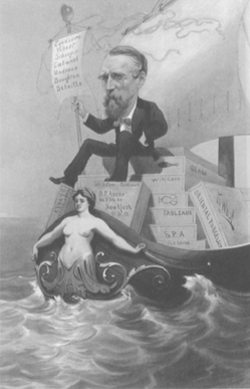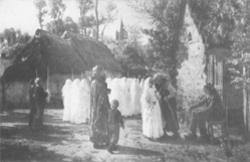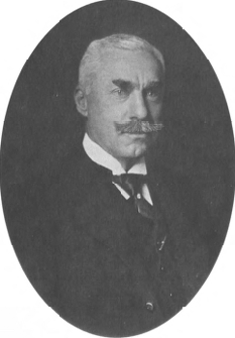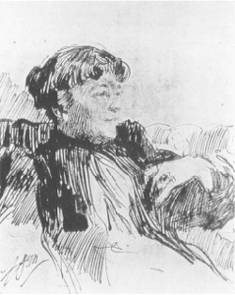Van Gogh Museum Journal 2000
(2000)– [tijdschrift] Van Gogh Museum Journal–
[pagina 100]
| |
 fig. 1
Jules Emile Saintin, Michel Knoedler, 1859, New York, Knoedler & Co. | |
[pagina 101]
| |
The American art trade and French painting at the end of the 19th century
| |
PreludeSelling art to Americans looked tempting from France as the audience seemed potentially inexhaustible, but it took some patience for French dealers to find ways to establish themselves in the new world.Ga naar voetnoot3 Adolphe Goupil (1806-1893), a key figure in the Parisian art market, sent at least two representatives to New York. Michel Knoedler (d. 1878) (fig. 1) arrived from France in 1846 and established a Goupil branch. He sold artist's materials as well as Goupil's publications and prints after Old Master and contemporary paintings. Knoedler was almost certainly also involved with Goupil and his associate Vibert's efforts to run the International Art Union, a lottery established around 1849.Ga naar voetnoot4 Within five or six years Knoedler had established a good rapport with American artists and began to buy their work. In 1857 he bought out Goupil's interest in the firm and conducted business under his own name, although he continued his association with his former employer on an informal basis. When Knoedler died in 1878, his 22-year-old son Roland became the head of the business. His younger brothers Edmond and Charles were involved in the firm until 1896. William Schaus (1820-1892) was another Goupil representative. Sent to New York around 1847 he, too, went on to establish himself as a dealer in his own right. In his early career Schaus published lithographic prints after paintings by American artists William Sidney Mount and Lily Martin Spencer.Ga naar voetnoot5 American-born dealers were active in trading French art as well. They came from a variety of backgrounds. Some emerged from allied trades such as the sale of artist's materials, picture frames, mirrors, chandeliers | |
[pagina 102]
| |
 fig. 2
Thomas Nast, caricature of Samuel P. Avery, 1870s, New York, The Metropolitan Museum of Art and various objects and services connected with interior design. Others had had some art training, as was the case with Samuel P. Avery (1822-1904), a native New Yorker who began his career as a wood engraver. He befriended local artists and began representing them in 1864. Had Avery limited his business to American art alone, his profits would probably not have been very great. With the help of a client, collector William T. Walters (1820-1894), who was then living in Paris, Avery received a consignment of over 100 European paintings that he successfully sold at auction in April 1864. The auction went so well that Avery continued to ‘manage’ similar events for the rest of his career. Walters worked with George A. Lucas (1824-1909), a fellow Baltimorian who went to Paris in 1857 and remained there for the rest of his life. Lucas acted as an art agent and advisor during the careers of both S.P. Avery and his son, S.P. Avery Jr (1847-1926).Ga naar voetnoot6 American art buyers and collectors came into contact with - and developed a strong affinity for - contemporary French art at the time of the Exposition Universelle in 1867.Ga naar voetnoot7 This was just after the Civil War and American buying power had reached a new height.Ga naar voetnoot8 For these novice art buyers, a painter's acceptance to the yearly Paris Salon was of utmost importance. Samuel Avery, who had been responsible for bringing and installing the American works at the Exposition, had several months to study the French art market and assess its appeal for Americans. He saw clearly that there was a future for him in trading in this art. George Lucas introduced Avery to artists and helped him launch himself as an international dealer. Thomas Nast's cartoon depicts Avery in this role, crossing the Atlantic with his neatly wrapped purchases (fig. 2). The Franco-Prussian War and its aftermath slowed down the sale of contemporary French art in the early 1870S. For a year or so artists in France had been unable to | |
[pagina 103]
| |
 fig. 3
Jules Breton, The communicants, 1884, present location unknown (photograph by John Watt) work and produced very little. Ever-eager American buyers found it difficult to purchase French academic painting. In 1871, just after the devastating Chicago fire, Adolphe Goupil created an opportunity to promote the sale of work by the artists he represented, or at least to keep their names before the American public: he asked ‘his’ artists (from Paris and Düsseldorf) to donate pictures for a charity auction sale in New York that would benefit victims of the catastrophe. The auction, held at Clinton Hall in 1872, was highly successful and brought in a total of over 43,000 dollars.Ga naar voetnoot9 | |
The infamous tariffBy the mid - 1870s there were again enough Parisian Salon paintings to keep up with American demand. The future looked bright for French art in the United States when suddenly importing work from abroad became a much more expensive proposition. In March 1883 the American Congress raised the customs duty on foreign works of art from 10 to 30 per cent. The London Art Journal estimated that Americans alone had spent 1,754,000 dollars at the Paris Salon that year, adding to collections that consisted almost exclusively of modern works, the majority of them French.Ga naar voetnoot10 This repressive tariff was not reduced until 1892, and then only to 15 per cent.Ga naar voetnoot11 In passing it should be noted that American artists were very much against the tariff, and signed petitions in favour of the free admission of works of art into American ports.Ga naar voetnoot12 | |
French art at American auctionsThere was surely a strong correlation between this tariff on imported foreign art and the rise of the American auction market. The number of art auctions rose from a handful before 1860 to 80 a year in 1876 and over go in 1882. Many works acquired by early buyers of contemporary French art changed hands during the mid - 1880s.Ga naar voetnoot13 These auctions provided a means of ‘recycling’ modern French works and were one way of avoiding the high import duties. There were auction houses in all large American cities, but New York was the place where the major events took place. Out-of-town collectors came in person or had agents to bid for them. Chickering Hall, a plush new 1800-seat concert auditorium was designed and built by George B. Post in 1875. It was located on Fifth Avenue at the north-west corner of 18th Street, close to the warehouses of the piano manufacturer Chickering & Sons, and was the site of a number of prestigious auctions.Ga naar voetnoot14 During the last 15 years of the 19th century a number of French Salon pictures fetched enormous or even record prices at New York auctions. A series of these were obtained at the Mary Jane Morgan sale, held at Chickering | |
[pagina 104]
| |
Hall from 3-5 March 1886. Viewers were so eager to see this highly publicised collection that they were more than willingly to pay the fifty-cent admission fee. At the sale itself, Jules Breton's Communicants (fig. 3), for which Mrs Morgan had paid 12,000 dollars in 1884, was sold for 45,000. It set a record as the highest price ever paid for a work by a living artist.Ga naar voetnoot15 A year after the Morgan sale, another famous collection - that of Alexander Turney Stewart (1803-1876) - was sold under similar circumstances.Ga naar voetnoot16 In the 1880s it became standard procedure for the New York newspapers to report on who attended the sales, who was bidding and the prices and names of the buyers who made major acquisitions. Auctions were so popular that articles in the press discussed the need for changing an old statute restricting these events to daytime hours.Ga naar voetnoot17 | |
Changes in dealing practicesSamuel Avery Jr (fig. 4) was in his early 40s when his father retired at the end of the 1880s. Although Sam Jr had been working in the business for over 30 years, his father did not wish him to continue as a dealer; in the end, however, his son prevailed upon him to allow him use the gallery name. With the help of an important backer, Sam Jr moved into new quarters on 5th Avenue and 36th Street, in the residential district known as Murray Hill.Ga naar voetnoot18 This was about a mile uptown from the area around 14th Street where most galleries had been located in the 1860s and 70s. Avery and Roland Knoedler were among the first art dealers in this new neighbourhood, but they were not alone for long.Ga naar voetnoot19  fig. 4
Samuel P. Avery, Jr, c. 1867, Glen Cove, NY, private collection | |
[pagina 105]
| |
Avery's gallery, at 368 Fifth Avenue, was built according the plans of his architect-brother Henry, and had several distinctive and novel features. Although it was but a modest two-story structure of Scottish redstone and Baltimore brick, it housed not only Avery Jr's own business, but also the Fifth Avenue Art Galleries auction house. For a short time, Henry Avery's architectural office was there as well.Ga naar voetnoot20 The lot on which the building stood was quite large, with a 35-foot front on Fifth Avenue and a return of 86 feet on 35th Street. Avery's galleries occupied the second floor, and were described in a promotional brochure as the largest local art gallery, with 500 feet of line and 5,000 feet of floor space, which Avery used for a series of one-man shows. Between 1888 and 1900, when auctioneer John Ortgies (1836-1909) retired, the Fifth Avenue Art Galleries organised 130 sales. Competition among European and American dealers was particularly strong in the 1880s and 90s. James Sutton (1843-1915), president of the American Art Galleries, another auction house and gallery facility, invited Paul Durand-Ruel to exhibit paintings in New York in March 1886. This was the first major show of paintings by the impressionists in the United States. In 1888 Durand-Ruel himself opened a branch of his gallery in New York, mainly as a means of coping with tariff complications.Ga naar voetnoot21 Americans who visited France were already familiar with his Paris gallery. Information about his professional activities had long appeared in publications intended for English-speaking tourists, and Americans began purchasing Barbizon paintings from him in the late 1860s.Ga naar voetnoot22 At home, American enthusiasm for the Barbizon School reached its peak on 1 July 1889, when James Sutton purchased Millet's Angelus in a heated battle at the Secretan sale in Paris. It cost 110,000 dollars and broke another auction record. At the time journalists boasted that Americans owned more masterpieces of French art than France itself.Ga naar voetnoot23 In fact, in the 1880s French officials do appear to have been somewhat concerned. They commissioned E. Durand-Greville (then on tour with his successful novelist wife) to catalogue French works in American collections. He spent six months on the task and published some of his findings in two articles in the Gazette des Beaux-Arts.Ga naar voetnoot24 Durand-Greville estimated that he had seen between 2,000 and 5,000 works by contemporary French artists. The Angelus, probably the best-known French painting in America, was the focal point of an exhibition entitled The works of A.L. Barye, his friends and contemporaries. It was held at the American Art Galleries and featured 100 French Barbizon works from private American collections. The public was required to pay fifty cents to see the Angelus, which received considerable attention.Ga naar voetnoot25 Thanks to American artists like William Morris Hunt, a Bostonian who had studied with Millet in the 1850s, Barbizon landscapes were appreciated in the United States quite early. Prices for these painting rose slowly through the 1860s and 70s, but their true commercial success only began in the 1880s. | |
The Midwest and the expansion of the art marketFrom 1873 to 1891 huge trade fairs were arranged to promote the city of Chicago as the foremost Midwest trading and industrial centre. Potter Palmer (1826-1902), who made his fortune in Chicago real estate, was the head of a corporation selling stock to finance construction of a monumental iron and glass building inspired by Europe's | |
[pagina 106]
| |
 fig. 5
Anders Zorn, Sara Tyson Hallowell, 1893, from The Art Amateur (photograph courtesy of The National Portrait Gallery, Washington, DC) Universal Exhibitions. Photographs of the 1878 Chicago Inter-State Industrial Exposition bear witness to the symbiotic relationship between art and business.Ga naar voetnoot26 Industrial goods were artistically displayed amidst works of art, which occupied the same spaces. Beginning in 1878, Sara Tyson Hallowell (1846-1924) (fig. 5) was clerk and secretary for the Industrial Exposition art committee. She was Chicago's most influential art agent and very active in getting work on loan from dealers and collectors.Ga naar voetnoot27 Established East Coast galleries were delighted to provide organisational support and lend paintings. Michel Knoedler was apparently the first dealer to go to Chicago, in 1875. Boston dealers Williams and Everett, Snedcor of New York, and Haseltine of Philadelphia followed in his footsteps. Just before the 1893 Columbian Exhibition, art journalists predicted that Chicago was going to become a major art centre.Ga naar voetnoot28 Certain art dealing practices at the Chicago fairs and elsewhere may seem surprising to us today. When Schaus lent William Dannat's 1884 Salon painting The | |
[pagina 107]
| |
Quatour (New York, The Metropolitan Museum of Art) to the Chicago industrial fair in 1885 he charged a 1,000-dollar fee. This the exhibition committee paid, passing the cost along by asking the public to pay ten cents for a look at it. It was common at this time for certain European art dealers - for example, Charles Sedelmeyer (1837-1925) - to sponsor tours of single works of art. Sedelmeyer brought several large Salon paintings to the United States. He charged admission fees and also hoped to generate income through the sale of engravings after them. | |
The new American tasteThe activities of private art agents at the end of the century did a great deal to make French art known to American buyers. Sara Hallowell, who lived in France for long periods of time, was on excellent terms with American artists abroad. She was especially friendly with Mary Cassatt and Gary Melchers. Hallowell worked closely with Paul Durand-Ruel and arranged for American collectors like Mr and Mrs Potter Palmer, Charles L. Freer and Charles Tyson Yerkes to meet French masters, among them Rodin.Ga naar voetnoot29 American artists who studied in Paris played an even more important role in determining the sort of French art Americans would buy. There was a long tradition for artists who studied abroad to act as informal advisors for their compatriots. In the 1870s Robert Wylie advised William Wilstach and helped him acquire French Salon paintings. Both men were from Philadelphia. In the 1880s Julius Alden Weir counselled an American named Erwin Davis, who began collecting while living abroad.Ga naar voetnoot30 Weir bought Manet's Woman with a parrot and Boy with a sword (New York, The Metropolitan Museum of Art) for Davis on his second trip to France in 1881. These were the first Manet paintings to enter American collections. Weir was actually following the advice of another American artist, William Merritt Chase, who had suggested that he go see Manet's work at the Durand-Ruel's.Ga naar voetnoot31 Upon returning from their studies in Europe, American artists like James Carroll Beckwith, Chase, Weir, Augustus Saint-Gaudens, Wyatt Eaton and Walter Shirlow influenced taste through their teaching. As artists they also participated in organising committees for exhibitions such as the loan show for the Statue of Liberty pedestal in 1883.Ga naar voetnoot32 Exhibitions arranged by art students coming home from France featured Barbizon School and other realist paintings, but showed very few French academic works. By the early 1890s prices for French Salon pictures were so inflated that it was rarely profitable for dealers to sell them. Their enormous size made them difficult to hang in the newly fashionable apartments that began to replace the palatial homes of the previous generation. Smaller French landscapes, on the other hand, sold well and they cost considerably less. In England and France Samuel Avery Jr could buy marines by Boudin for between 100 and 200 dollars and could thus make a greater profit on them than on larger academic works.Ga naar voetnoot33 Impressionist works, which were also much less expensive, entered American collections by the early 1890s. At the same period there were new bargains to be had the areas of 18th and early-19th century English portraiture and landscape paintings.Ga naar voetnoot34 Italian Renaissance work appealed to collectors like Isabella Stewart Gardner, who was guided by Bernard Berenson. Around 1890, at the end of his career, William Schaus, who began as Goupil's agent in 1847 and then sold French academic work in the 1870s and 80s, was negotiating in sales for Old Master paintings. The art press noted that such works were all the rage.Ga naar voetnoot35 By the last decade of the 19th century, in fact, acquiring French Salon art, once seen by American buyers as the only viable investment, had become just one of a growing number of options. |
|

